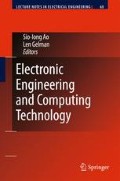Abstract
A Sparse Distributed Memory (SDM) is a kind of associative memory suitable to work with high-dimensional vectors of random data. This memory model exhibits the characteristics of a large boolean space, which are to a great extent those of the human long-term memory. Hence, this model is attractive for Robotics and Artificial Intelligence, since it can possibly grant artificial machines those same characteristics. However, the original SDM model is appropriate to work with random data. Sensorial data is not always random: most of the times it is based on the Natural Binary Code and tends to cluster around some specific points. This means that the SDM performs poorer than expected. As part of an ongoing project, in which the goal is to navigate a robot using a SDM to store and retrieve sequences of images and associated path information, different methods of encoding the data were tested. Some methods perform better than others, and one method is presented that can offer the best performance and still maintain the characteristics of the original model.
Access this chapter
Tax calculation will be finalised at checkout
Purchases are for personal use only
References
Bose, J.: A scalable sparse distributed neural memory model. Master’s thesis, University of Manchester, Faculty of Science and Engineering, Manchester, UK (2003)
Furber, S.B., Bainbridge, J., Cumpstey, J.M., Temple, S.: Sparse distributed memory using n-of-m codes. Neural Networks 17(10), 1437–1451 (2004)
Hely, T.A., Willshaw, D.J., Hayes, G.M.: A new approach to kanerva’s sparse distributed memories. IEEE Trans. Neural Networks (1999)
Jockel, S., Mendes, M., Zhang, J., Coimbra, A.P., Crisóstomo, M.M.: Robot navigation and manipulation based on a predictive associative memory. In: Proceedings of the 2009 IEEE 8th International Conference on Development and Learning (ICDL), Shanghai, China (2009)
Kanerva, P.: Sparse Distributed Memory. MIT Press, Cambridge (1988)
Matsumoto, Y., Inaba, M., Inoue, H.: View-based approach to robot navigation. In: Proceedings of 2000 IEEE/RSJ International Conference on Intelligent Robots and Systems (IROS 2000) (2000)
Mendes, M., Coimbra, A.P., Crisóstomo, M.: AI and memory: Studies towards equipping a robot with a sparse distributed memory. In: Proceedings of the IEEE International Conference on Robotics and Biomimetics, Sanya, China (2007)
Mendes, M., Crisóstomo, M., Coimbra, A.P.: Robot navigation using a sparse distributed memory. In: Proceedings of the 2008 IEEE International Conference on Robotics and Automation, Pasadena, CA (2008)
Mendes, M., Crisóstomo, M., Coimbra, A.P.: Assessing a sparse distributed memory using different encoding methods. In: Proceedings of the 2009 International Conference of Computational Intelligence and Intelligent Systems, pp. 37–42. London, UK (2009)
Rao, Rajesh P.N., Fuentes, O.: Hierarchical learning of navigational behaviors in an autonomous robot using a predictive sparse distributed memory. Mach. Learn. 31(1–3), 87–113 (1998)
Ratitch, B., Precup, D.: Sparse distributed memories for on-line value-based reinforcement learning. In: ECML (2004)
Rogers, D.: Predicting weather using a genetic memory: a combination of kanerva’s sparse distributed memory with holland’s genetic algorithms. In: NIPS (1989)
Vanhala, J., Saarinen, J., Kaski, K.: Sparse distributed memory for multivalued patterns. In: IEEE Int. Conf. Neural Networks (1993)
Author information
Authors and Affiliations
Corresponding author
Editor information
Editors and Affiliations
Rights and permissions
Copyright information
© 2010 Springer Science+Business Media B.V.
About this chapter
Cite this chapter
Mendes, M., Crisóstomo, M.M., Coimbra, A.P. (2010). Encoding Data to Use with a Sparse Distributed Memory. In: Ao, SI., Gelman, L. (eds) Electronic Engineering and Computing Technology. Lecture Notes in Electrical Engineering, vol 60. Springer, Dordrecht. https://doi.org/10.1007/978-90-481-8776-8_25
Download citation
DOI: https://doi.org/10.1007/978-90-481-8776-8_25
Published:
Publisher Name: Springer, Dordrecht
Print ISBN: 978-90-481-8775-1
Online ISBN: 978-90-481-8776-8
eBook Packages: EngineeringEngineering (R0)

